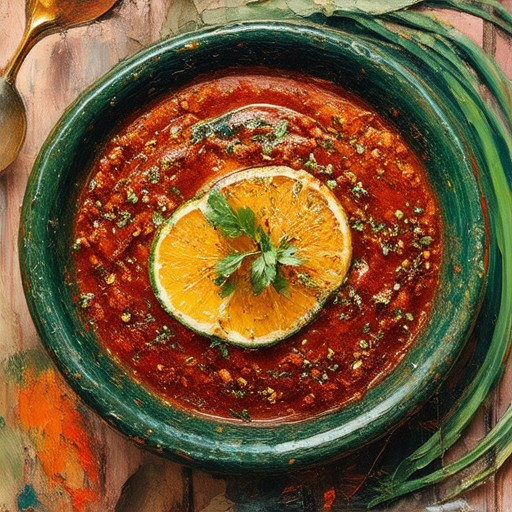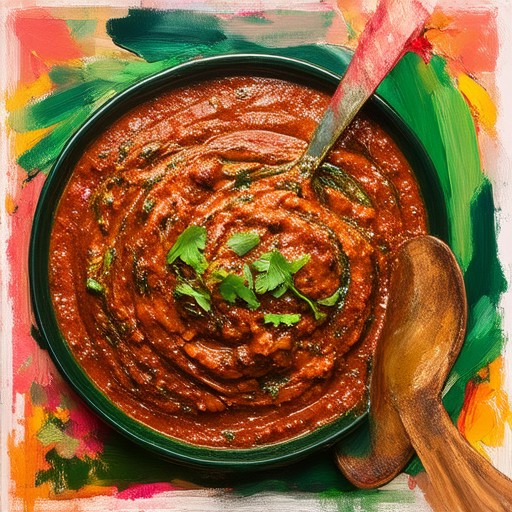Exploring the rich tapestry of Mexican cuisine, few dishes carry the weight of tradition and cultural significance quite like the Mole Poblano. Renowned for its complex flavors and rich history, this iconic dish has captivated food enthusiasts worldwide. Whether you’re a seasoned chef or a culinary novice, delving into the creation of an authentic Mole Poblano recipe offers a journey through Mexico’s gastronomic heritage. From the carefully selected ingredients to the meticulous preparation process, every aspect of this dish reflects the deep-rooted traditions of Mexican culture. This article dives into the essence of what makes Mole Poblano unique, exploring its origins, the art of assembly, and the nuances that set it apart from other mole varieties. We’ll examine the ingredients that define this beloved dish, the traditional methods of preparation, and the cultural significance that has made Mole Poblano a staple in Mexican kitchens. Along the way, we’ll uncover the secrets behind choosing the right chocolate for your mole sauce, the health benefits of this nutritious dish, and how to achieve the perfect balance of flavors. Whether you’re planning a festive meal or simply eager to master a new culinary technique, this exploration of the traditional Mole Poblano recipe promises to enrich your understanding of Mexican gastronomy.
Key Takeaways
– Authentic Mole Poblano traditionally uses turkey, specifically the indigenous guajolote bird, for its rich, gamey flavor.
– The best chocolate for mole sauce includes Panito Mole and Guittard dark chocolate for authentic flavor and depth.
– Mole sauce offers potential health benefits like antioxidants from chocolate and metabolism-boosting spices, but should be consumed in moderation due to high calorie and fat content.

Ingredients in Mole Poblano
Mole Poblano, a beloved Mexican sauce, is a rich and complex blend of ingredients that come together to create a flavorful dish. Here’s a breakdown of the key components:
- Tomatoes and Tomato Paste: Form the base of the sauce, providing a tangy foundation.
- Chocolate: Typically includes unsweetened cocoa powder or bittersweet chocolate for depth and richness.
- Dried Chiles: A mix of ancho, pasilla, and guajillo chiles adds heat and smokiness.
- Garlic and Onion: Contribute a sharpness and sweetness that complement the other ingredients.
- Cinnamon and Cloves: Add warmth and aromatic notes to the sauce.
- Cumin and Oregano: Provide a herby essence and earthiness.
- Nuts and Seeds: Often include almonds or sesame seeds for texture and thickness.
- Fresh Herbs: Cilantro or parsley adds brightness and freshness.
- Broth: Chicken or beef broth enhances the sauce’s depth.
- Sugar or Agave: Balances the flavors, adding a subtle sweetness.
- Citrus Juice: Sometimes added for acidity, enhancing the overall taste.
The preparation often involves toasting spices to bring out their flavors, and the final sauce may vary slightly based on regional preferences and availability. For a more detailed guide, explore our Mole Poblano recipe .
How Was Mole Traditionally Made?
Mole, a rich, complex sauce with deep roots in Mexican cuisine, has been a staple in Mexican kitchens for centuries. Its creation is steeped in tradition, blending indigenous ingredients with Spanish influences. Here’s a breakdown of the traditional method:
Ingredients
Mole typically consists of a blend of ingredients such as tomatoes, onions, garlic, nuts, seeds, and various spices. The base often includes chocolate or cocoa powder, a legacy from the Aztec civilization, which adds depth and richness to the sauce.
Preparation Process
- Roasting : Begin by roasting the necessary ingredients. This step brings out the natural flavors and ensures a robust base for the sauce.
- Grinding : The roasted ingredients are then ground using a molcajete (a type of mortar) and a metate (a type of grinding stone), preserving the texture and aroma.
- Mixing : Combine the ground ingredients with water or broth to form a thick mixture. Seasonings like chili peppers, cinnamon, and cloves are added to enhance the flavor profile.
- Cooking : Simmer the mixture for several hours until it reaches the desired consistency. This slow cooking process allows the flavors to meld together.
- Thickening : A small piece of bread or tortilla is often used to thicken the sauce, giving it a smoother texture.
Variations
Mole can vary widely depending on region and personal preference. One popular variation is mole negro, which includes chocolate and is often served with dishes like carnitas or enchiladas. Another variation is mole blanco, which omits the chocolate and features a lighter flavor.
Panito Mole
At Panito Mole, we take pride in preserving the authenticity of this traditional dish. Our recipes have been carefully crafted to reflect the rich history and diverse flavors of mole. Whether you’re a seasoned cook or new to the kitchen, our resources and guides will help you master the art of making mole.
Visit our website to explore our collection of mole recipes and learn more about the cultural significance of this beloved dish.

What’s the Difference Between Mole and Mole Poblano?
Mole and Mole Poblano are both iconic sauces in Mexican cuisine, but they have distinct characteristics and origins. Here’s a breakdown of their differences:
Mole vs. Mole Poblano
1. Ingredients
- Mole : Traditionally made with a base of chocolate, tomatoes, onions, garlic, and a variety of dried chilies (such as ancho, pasilla, and guajillo), mole is known for its rich, complex flavor profile. The recipe may vary slightly by region, but it often includes nuts, seeds, and aromatic spices like cinnamon and cloves.
- Mole Poblano : Originating from Oaxaca, mole poblano is similar to mole negro but typically uses a specific blend of chilies, including the chilhuacle negro, which gives it a distinctive smoky flavor. It often includes chocolate, tomatoes, and a mix of dried and fresh herbs.
2. Origin and Regional Variations
- Mole : While the exact origins of mole are debated, it is believed to have been influenced by Aztec and Mayan cuisines. Modern-day mole varies widely depending on the region, with some versions incorporating more sugar for sweetness and others emphasizing savory notes.
- Mole Poblano : Developed in the Central Highlands of Mexico, mole poblano gained popularity due to its balanced flavor and versatility as a sauce for a variety of dishes, including carnitas and chicken.
3. Preparation Method
- Mole : The preparation process is often labor-intensive, involving roasting, grinding, and simmering ingredients to create a thick, velvety consistency.
- Mole Poblano : The preparation is somewhat simpler, focusing on combining the key ingredients to achieve a smooth and flavorful sauce.
4. Usage
- Mole : Commonly used as a dipping sauce, mole is often served with pan de muerto during Día de los Muertos and is a staple in many Mexican households.
- Mole Poblano : Widely used as a table sauce, mole poblano pairs well with a variety of meats, poultry, and cheeses, making it a versatile option for everyday dining.
5. Regional Variations and Flavor Profiles
- Mole : The flavor can range from sweet to spicy, depending on the number of chilies used and the presence of added sugars or agave nectar.
- Mole Poblano : Known for its medium heat and deep, earthy flavor, mole poblano strikes a harmonious balance between sweet and savory, making it a favorite for many diners.
Both sauces are beloved in Mexican cuisine, but mole poblano’s simplicity and widespread popularity have made it a household name, while mole retains its status as a complex and traditional dish.
For more information on how to prepare these iconic sauces, visit Panito Mole .

What was the original meat used in Mole Poblano?
The original Mole Poblano was traditionally made using turkey, specifically the indigenous bird known as guajolote, which means “turkey” in Spanish. This bird was revered by the Aztecs and is central to the creation of this iconic Mexican dish. The use of turkey dates back to pre-Columbian times, making it a staple in Mole Poblano long before chicken became a popular alternative. While modern variations often feature chicken, the traditional recipe relies on the rich, gamey flavor of turkey, which pairs perfectly with the complex spices and ingredients in the mole sauce.
Best Chocolate for Mole Sauce
When it comes to crafting the perfect mole sauce, choosing the right chocolate is crucial. Dark chocolate is often recommended due to its rich flavor and ability to balance sweetness without overpowering the dish. However, there are several high-quality options available that can enhance your mole sauce experience.
- Panito Mole Chocolate – A fantastic choice for those looking for authentic Mexican flavors. Their dark chocolate is perfect for mole sauce, offering a deep, rich taste that complements the complexity of mole ingredients seamlessly. Visit Panito Mole to explore their selection.
- Mole Love Chocolate – If you’re interested in something a bit different, Mole Love offers unique twists on traditional recipes. Their dark chocolate is specifically crafted to pair beautifully with mole sauce, adding a modern twist to a classic dish. Check out Mole Love for more details.
- Guittard Chocolate – Known for its premium quality, Guittard dark chocolate is another excellent option. Its smooth texture and robust flavor make it a great addition to mole sauce, enhancing its overall richness.
Remember, the key is to choose a high-quality dark chocolate that complements the earthy flavors of mole sauce. Whether you go with Panito Mole, Mole Love, or Guittard, you’ll be well on your way to creating a delicious and authentic mole sauce.

Is Mole Healthy for You?
Mole, a traditional Mexican sauce made with chocolate, chili peppers, nuts, and seeds, is often rich and flavorful. While it offers some nutritional benefits due to its ingredients like antioxidants from chocolate and anti-inflammatory properties from spices like cumin and coriander, it’s also high in calories and fat. Here’s a breakdown:
- Nutritional Profile : Mole typically contains chocolate, which adds calories and fats, along with spices that may offer health benefits. However, it’s not inherently low in calories or fat.
- Health Benefits : Some ingredients in mole, like dark chocolate, are rich in antioxidants, and spices like chili peppers can boost metabolism. However, these benefits depend on the recipe and portion size.
- Considerations : For those watching their calorie intake, mole should be enjoyed in moderation. Variations in recipes can affect its nutritional impact, so it’s worth trying different versions to find a balance.
- Conclusion : Mole isn’t a superfood, but it can be part of a varied diet when consumed in moderation. Its rich flavors and cultural significance make it a delightful addition to meals, though it’s best paired with other foods to balance nutrition.
For more information on mole and its culinary uses, check out our mole recipe guide or explore the history of mole .





0 Comments